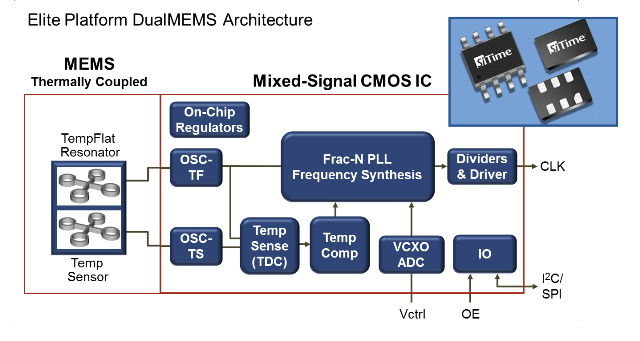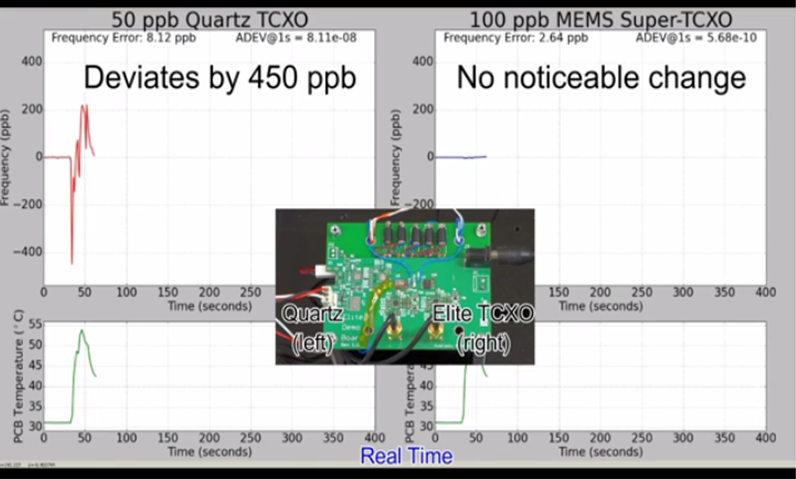For the telecom and networking-timing markets, a new group of MEMS-based temperature-controlled oscillators (TCXOs) and differential oscillators were engineered to solve telecommunications/networking equipment problems that are coming to the fore today. As SiTime CEO Rajesh Vashist explains, “Network densification is driving rapid deployment of equipment in uncontrolled environments, such as basements, curbsides, rooftops, and on poles.” As a result, oscillators must now operate in the presence of high temperature, thermal shock, vibration, and unpredictable airflow — conditions that are extremely challenging to quartz-based-oscillator performance.

To overcome these environmental challenges, the devices in the group, which is referred to as the Elite Platform, are based on a dual-MEMS architecture that uses extremely rapid compensation algorithms. The architecture has three key elements. The first is robust, reliable, and proven MEMS technology, TempFlat, that eliminates activity dips and enables 30 times better vibration immunity than quartz. The second is use of two separate MEMS devices, one of which is dedicated to temperature sensing, thereby enabling 40 times faster temperature. The third is highly integrated mixed-signal circuits with on-chip regulators, a temperature-to-digital converter, and a low-noise phase-locked loop; the circuitry delivers five times better immunity to power-supply noise than other devices, 30-µK resolution (10 times better than quartz), and support for any frequency between 1 and 700 MHz. Because of this architecture, all Elite Platforms solutions offer 0.1 ppb/g vibration immunity and do not have activity dips or micro-jumps. (See video below. )
As to the individual devices, the high-end device is a Stratum-3-compliant, precision Super-TCXO for core and edge networks. Over a 1- to 200-MHz range, it offers ±100-ppb frequency stability over −40°C to 105°C, the widest operating temperature available with any TCXO, and a 1 to 5 ppb/°C frequency slope (ΔF/ΔT) at an extremely fast temperature ramp rate of 10°C/minute, a performance level that is unique among timing devices. It also provides a 3e-11 Allan deviation (ADEV) at 10-second averaging time, 10 times better than typical quartz TCXOs, and 0.2-ps/mV power supply noise rejection (PSNR), which eliminates the need for a low-dropout (LDO) regulator to clean up power. Using built-in I2 C/SPI frequency tuning eliminates the need for an external DAC. The second device — the Super-TCXO — is intended for GNSS, industrial, and automotive applications, with similar performance to the precision Super-TCXO but with slightly lower frequency stability, ±0.5 ppm, over the same wide −40°C to 105°C range.
The high-temp, high-rel, differential VCXO operates to 105°C in the 1 to 700 MHz range, with a wide pull range of ±25 to ±3,600 ppm, and 0.1% frequency-tuning linearity under all conditions, 50 times better than quartz. The ultra-low jitter differential oscillator (XO), which operates over a 1 to 700 MHz range, has just 0.23 ps of integrated rms phase jitter from 12 kHz to 20 MHz, and 0.1 ps integrated rms phase jitter under Ethernet mask for 10G/40G/100G. Frequency stability over the specified −40°C to 95°C.
Engineering samples of the latter two oscillators are available now to qualified customers, with the prices from $5.5 ea. in 1K quantities. Samples of and pricing for the Super-TCXOs are expected in the first half of 2017.
Advertisement
Learn more about SiTime






